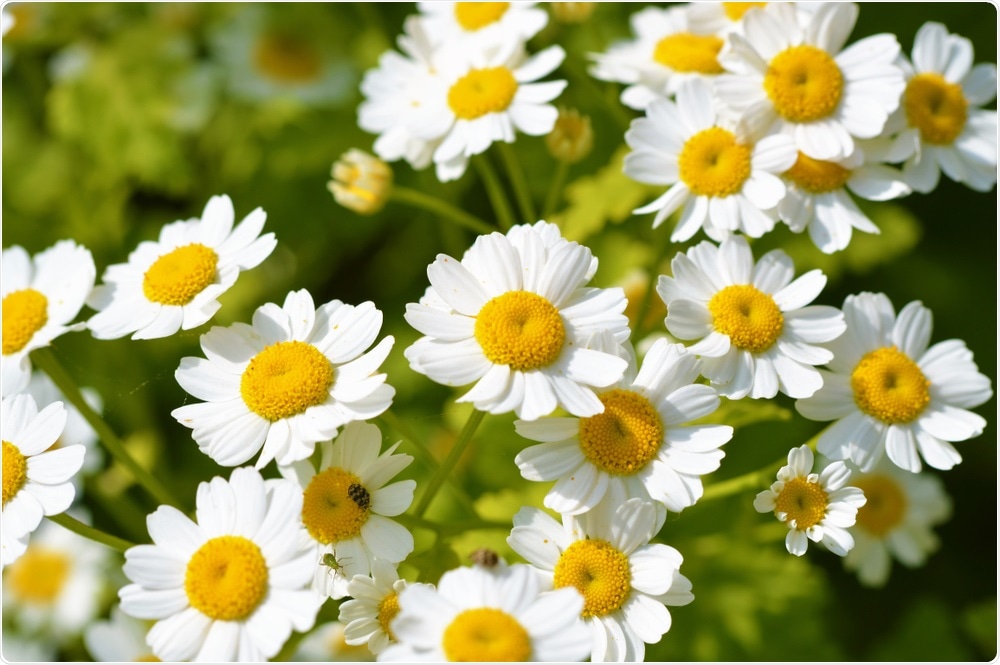Researchers at Birmingham University have discovered how to turn a compound from a common wildflower called Feverfew into a new treatment for cancer.
The team found a way to extract the naturally-occurring substance, called parthenolide, from the plant’s leaves and modify it so that it could destroy chronic lymphocytic leukemia (CLL) cells. CLL is a common form of leukemia that typically affects older people.
 Paul Stout | Shutterstock
Paul Stout | Shutterstock
John Fossey, from the university's school of chemistry, says: "This research is important not only because we have shown a way of producing parthenolide that could make it much more accessible to researchers, but also because we've been able to improve its 'drug-like' properties to kill cancer cells… It's a clear demonstration that parthenolide has the potential to progress from the flowerbed into the clinic."
New treatments are needed for chronic lymphocytic leukemia
CLL is the most common form of leukemia in adults, with more than 3,000 people diagnosed in the UK annually. Its clinical course is variable, ranging from stable, indolent disease that is not necessary to treat through to rapidly progressing disease that requires immediate intervention.
Patient response rates to treatment strongly depend on genetic changes including those that disrupt the DNA damage (DDR) response genes ATM and p53. Tumors that have or develop a DDR defect are refractory to chemotherapeutic agents because they cannot induce apoptosis in response to the DNA damage caused by therapy. This means these tumors cannot be treated with the usual DNA-damaging chemotherapies.
Furthermore, the majority of patients with CLL are over the age of 60 and often have other illnesses that contraindicate the use of aggressive chemotherapeutic approaches.
“This highlights a need to develop alternative, less aggressive, therapies for the treatment of CLL,” write Fossey and colleagues.
About the Feverfew plant
Feverfew is a strong-smelling herb, similar looking to chamomile, that grows on roadsides, wasteland and gardens in the UK. It is commonly sold in health food shops as a remedy for various ailments.
As the name suggests, it was primarily used as a treatment for fever, but other ailments it has been used to treat include psoriasis, dermatitis, allergies, arthritis, asthma, rheumatoid arthritis, toothache, insect bites earache, tinnitus, nausea, vomiting, dizziness, digestive problems infertility and problems with menstruation and childbirth.
It is a traditional herbal medicine that dates all the way back the ancient Greeks and early European herbalists. It is now widely cultivated across large regions of the world and its importance as a medicinal agent is growing significantly, the more researchers report on its therapeutic effects.
The Feverfew plant contains a wide range of natural substances, but the active agents include one or more of the sesquiterpene lactones, including parthenolide.
The anti-cancer properties of the parthenolide compound were identified by scientists several years ago. Although it is available commercially, it is costly and exhibits poor drug-like properties, meaning it has not progressed beyond basic research.
Creating an effective treatment
Now, Fossey and colleagues have not only developed a way of making the compound directly from Feverfew, but they have also modified it to produce various compounds that are effective at killing cancer cells in the laboratory. The properties that these compounds possess show much more promise as drug candidates for use in the clinic.
The team’s protocol for growing, extracting and derivatizing parthenolide obtained from Feverfew is described in the journal MedChemComm.
The researchers used both established and modified methods to prepare parthenolide derivatives by adding primary or secondary amines to the compound. The drug-like properties of these derivatives were computed and then screened for the anti-leukemic activity against the refractory MEC1 CLL cell line.
A screening cascade identified the most active compounds and their properties, which led to the identification of a new compound with good anti-CLL activity and fewer drawbacks than some of the main compounds reported on in the literature. The compound also worked against drug-resistant disease.
The compound appears to kill cancer cells by increasing their levels of reactive oxygen species (ROS). These unstable ROS molecules are already present at increased levels in cancer cells, but parthenolide increases these levels to a critical point, which causes the cancer cells to die.
Who was involved in the research?
The study was a multidisciplinary effort, bringing together researchers from the University's Institute of Cancer and Genomic Studies, the School of Chemistry and the drug discovery companies, Sygnature Discovery and Apconix.
The research was initiated by Angelo Agathanggelou (Institute of Cancer and Genomic Studies), who is exploring new ways to treat CLL.
"There are several effective treatments for CLL, but after a time the disease in some patients becomes resistant,” says Agathanggelou.
“We were interested in finding out more about the potential of parthenolide. With expertise from colleagues in the School of Chemistry we've been able to demonstrate that this compound shows real promise and could provide alternative treatment options for CLL patients," he concludes.
Journal reference:
Li, X., et al. (2019). Derivatisation of Parthenolide to Address Chemoresistant Chronic Lymphocytic Leukaemia. Med Chem Comms. https://pubs.rsc.org/en/content/articlelanding/2019/md/c9md00297a#!divAbstract